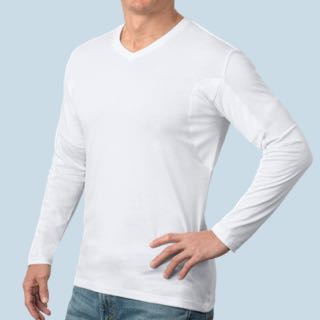What is Anti-Odor Technology? Your Guide to the Best Anti-Odor Fabrics
Anti-odor technology and fabrics are everywhere, from workout clothes to performance dress shirts and undershirts.
But does anti-odor technology actually work? How does it work? And are anti-odor clothes harmful to your health?
Today we’re tackling everything body odor and clothing. We’ll break down exactly what anti-odor technology is, explore the connection between body odor and artificial fabrics, and share the best anti-odor fabrics to help you stay fresh and confident.
What is Anti-Odor Technology?
To start, let’s clarify a few terms.
Sweat isn’t the culprit of B.O. — body odor occurs when sweat reacts with bacteria that live on your skin. Sweat, on its own, is odorless.
Anti-odor technology captures and blocks or kills odor-causing bacteria that comes from your body. It neutralizes the bacteria before it interacts with sweat, reducing the amount of body odor. When bacteria can't mix with the moisture from your sweat, odors vanish.
Anti-odor technology is often confused with moisture-wicking, especially when you’re talking about athletic or workout clothes. But they’re not the same.
Moisture-wicking fabrics push moisture away from the body. They contain polyester, which doesn’t absorb as much water as cotton. Moisture-wicking fabrics help you cool down, but they don’t control odor.
There are many different factors to consider when choosing anti-odor clothing, including efficacy and safety.
The Best Anti-Odor Technology
The most popular anti-odor options include chemically treated antimicrobial fabrics, fabric woven or treated with silver and volcanic ash treated fabrics.
Let’s take a look at each of the different types to see how they compare.
Antimicrobial Fabrics
Antimicrobial fabrics kill or inhibit the growth of bacteria. There are two main types of technology utilized to create odor-blocking materials:
- Antimicrobial chemicals: Triclosan and triclocarban are the two main antimicrobial chemicals used to treat clothing. They weaken the cell membrane of bacteria, causing the bacteria to die.
- Silver technology: Silver is naturally antimicrobial. When it oxidizes, it releases silver ions that are lethal to bacteria. Silver is incorporated into fibers and woven into the material.
Silver is most commonly found in workout wear, although some t-shirts, leggings and socks also incorporate it into their fabric.
But how do they hold up to testing?
Chemically-treated fabrics and silver thread clothing are effective at keeping odors at bay during initial use, but tests show that they lose efficacy after washing. One study found that within ten washes, more than half of the antimicrobial properties of the clothing had washed away.
Some manufacturers suggest that you don’t need to wash odor-blocking fabric as frequently, which may increase its longevity. However, if you’re a heavy sweater, washing your clothing often is inevitable.
There are also questions about the safety of these chemicals.
Another study showed that triclosan, one of the antimicrobial chemicals, disrupts the endocrine system. The U.S. Food and Drug Administration removed it from soap as a result. Doctors are also concerned that antimicrobial clothing may be breaking down the body’s microbiome, a type of “good” bacteria that keeps us healthy.
Additionally, when these chemicals and compounds wash out of your clothing, they contaminate the water supply and jeopardize marine life.
In summary? Antimicrobial clothing is effective at controlling odor, but the side effects and longevity may not be worth it.
Zeolites
Zeolites are volcanic ash mixed with alkaline water.
Mineral-based zeolites capture and break down odor molecules and release them in the wash. Since materials enhanced with zeolites degrade odors, they don’t require as much laundering as regular clothing.
However, zeolites are relatively unproven technology. There is no significant scientific testing for this technology, although field tests show that it’s effective for keeping odors at bay. More testing is needed to determine if this technology is safe for use, but it seems promising.
Hydrogen Peroxide-Treated Clothing
Hydrogen peroxide has a long history of being used as a disinfectant because of its nontoxic ability to kill bacteria. It exposes bacteria to oxygen (called oxidation), and since the bacteria can't live in a high-oxygen environment, they die.
Many research studies highlight hydrogen peroxide’s efficacy in disinfecting hospitals. Hydrogen peroxide is also a household hack - use it to remove yellow armpit stains or as an ingredient in natural deodorant.
We know hydrogen peroxide is a nontoxic bacteria-killing powerhouse. But what if this combination of water and oxygen molecules could also help create a safe, odor-resistant fabric?
By treating clothing with hydrogen peroxide, the fibers can prevent odor as effectively as other methods. In fact, Thompson Tee’s Odor Shield™ technology uses a natural hydrogen peroxide-based solution to eliminate 99.9% of bacteria when infused in fabric. The technology holds up for at least 70 wash cycles, proving hydrogen peroxide-treated materials have increased longevity compared to antimicrobial fabrics.
The Connection Between Body Odor and Artificial Fabrics
When shopping for clothing with anti odor technology, you'll want to pay close attention to the label. While nearly all anti-odor clothing is made with synthetic or artificial materials, that doesn't mean all artificial fabrics are capable of controlling B.O.
Here are the most common artificial fabrics:
- Nylon
- Polyester and polyester fleece
- Spandex
- Acrylic
- Olefin
- Microfiber
- Neoprene
- Vinylon
- Synthetic fur, suede and leather
The above make up some of these branded synthetic fabrics you may recognize: Gore-Tex, Lycra, Polartec, Dri-FIT and CoolMax.
However, artificial fabrics can actually worsen body odor. Artificial fabrics are hydrophobic, meaning they repel water, but they are also oleophilic, or oil-loving. So although these fabrics can wick away sweat, they'll leave behind the oily substance that's in your sweat, creating an optimal environment for bacteria growth.
Essentially, artificial fabrics intensify the smell of body odor due to their synthetic, non-natural material and construction. It’s nearly impossible to prevent odor from flourishing on these fabrics or remove it with washing.
If you're searching for fabrics that don't have anti-odor technology but are still odor-resistant, look for natural materials such as cotton, bamboo, merino wool, linen, hemp or a blend of those fibers.
Prevent Odor the Nontoxic Way
Thompson Tee’s Premium Anti Odor Undershirt, available in crewneck or V-neck styles, contains Odor Shield™ technology, a natural non-toxic hydrogen peroxide-based solution that eliminates 99.9% of odor causing bacteria in the fabric. They’re a safe and effective solution for fighting odor — guaranteed. Get rid of B.O. and regain your confidence today!
Try a Thompson Tee risk-free!


